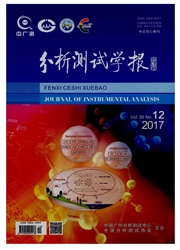

 中文摘要:
中文摘要:
考察了几种特色南药中重金属(Cd,Cr,Cu,Fe,Mn,Ni,Pb,Sr,Zn)的含量状况,并采用形态连续萃取法分析重金属在药材中的形态分布,研究了药材煎煮时药材中重金属的释放及煎煮过程对药材中重金属形态分布的影响。结果表明,几种南药中Cr,Pb,Zn的含量较高,且巴戟天中的重金属总量高于限量标准;原药材中Cr,Cu,Mn,Ni,Pb和Zn主要存在于有机态和残留态,Fe和Sr主要存在于残留态。煎煮使南药中大量重金属迁移到药汤中;药汤中Cu,Mn,Cr,Pb和Zn主要来自于其在药材中的可交换态、碳酸盐结合态和有机态,而药汤中Sr,Ni和Fe不仅包含其非残留态,更多来自于它们的残留态。为减少药汤中重金属,对于Cu,Mn,Cr,Pb和Zn既要控制在药材中的总量,且需降低它们在药材中的非残留态含量;对于Fe,Ni和Sr则主要是控制其在药材中的总量。
 英文摘要:
英文摘要:
The concentrations of heavy metals(Cd,Cr,Cu,Fe,Mn,Ni,Pb,Sr,Zn) in several South China Medicines were investigated,the speciation of heavy metals were analyzed by the continuous extraction method,and the impact of decoction on contents and speciation of heavy metals were also studied.The results showed that,the concentrations of Cr,Pb,Zn were high in several medical herbs,and the total concentrations of heavy metals in Morinda officinalis were higher than the values of the limit standard.Cr,Cu,Mn,Ni,Pb and Zn in raw medicinal herbs mainly existed as the organic fraction and residual fraction,Fe and Sr mainly existed as residual fraction.A large amount of heavy metals in South China Medicine released to the medicine soup by decocting.Cu,Mn,Cr,Pb and Zn in medicine soup mainly derived from the exchangeable,carbonate bound and organic speciation in the medicinal herbs.Sr,Ni and Fe in medicine soup mainly derived from their residual fraction.The total concentrations and non residual amounts of Cu,Mn,Cr,Pb and Zn were required to keep in control to reduce the concentrations of heavy metals in the medicine soup,and the total concentrations of Fe,Ni and Sr were required to be in control in minority herbs.
 同期刊论文项目
同期刊论文项目
 同项目期刊论文
同项目期刊论文
 期刊信息
期刊信息
